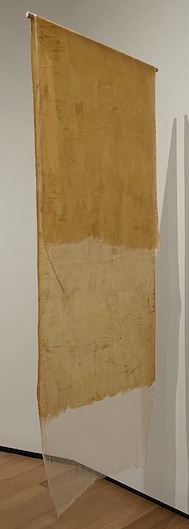Eva Hesse
Eva Hesse (January 11, 1936 – May 29, 1970) was a German-born American sculptor known for her pioneering work in materials such as latex, fiberglass, and plastics.
[4][5] After almost six months of separation, the reunited family moved to England and then, in 1939, emigrated to New York City [6] where they settled into Manhattan's Washington Heights.
[11] Hesse graduated from New York's School of Industrial Art at the age of 16, and in 1952 she enrolled in the Pratt Institute of Design.
[1][13][14] After Yale, Hesse returned to New York,[15] where she became friends with many other young minimalist artists, including Sol LeWitt, Donald Judd, Yayoi Kusama, and others.
[20] In 1963, Eva Hesse had a one-person show of works on paper at the Allan Stone Gallery on New York's Upper East Side.
[23] Hesse and Doyle, whose marriage was by then falling apart,[24] lived and worked in an abandoned textile mill in Kettwig-on-the-Ruhr near Essen for about a year.
[citation needed] Her first sculpture was a relief titled Ringaround Arosie, which featured cloth-covered cord, electrical wire, and masonite.
Returning to New York City in 1965, she began working and experimenting with the unconventional materials that would become characteristic of her ouptut: latex, fiberglass, and plastic.
Art critic John Keats stated: "immediacy may be one of the prime reasons Hesse was attracted to latex".
In her artwork Untitled (Rope Piece), Hesse employed industrial latex and once it was hardened, she hung it on the wall and ceiling using wire.
"[30] Hesse's work often employs multiple forms of similar shapes organized together in grid structures or clusters.
Retaining some of the defining forms of minimalism, modularity, and the use of unconventional materials, she created eccentric work that was repetitive and labor-intensive.
Arthur Danto distinguished post-minimalism from minimalism by its "mirth and jokiness," its "unmistakable whiff of eroticism," and its "nonmechanical repetition.
[33] Many feminist art historians have noted how her work successfully illuminates women's issues while refraining from any obvious political agenda.
"[36][11] Hesse's work often shows minimal physical manipulation of a material while simultaneously completely transforming the meaning it conveys.
With the exception of fiberglass, most of her favored materials have aged badly, so much of her work presents conservators with an enormous challenge.
Arthur Danto, writing of the Jewish Museum's 2006 retrospective, refers to "the discolorations, the slackness in the membrane-like latex, the palpable aging of the material… Yet, somehow the work does not feel tragic.
Hesse's close friend Sol LeWitt argued for steps for active conservation, "She wanted her work to last ... She certainly didn't have the attitude that she would mutely sit by and let it disintegrate before her eyes.
It "focuses on those years of artistic emergence, a period of rapid development and furious productivity, with few parallels in the history of art.
Arthur Danto connects the two by describing her as "cop[ing] with emotional chaos by reinventing sculpture through aesthetic insubordination, playing with worthless material amid the industrial ruins of a defeated nation that, only two decades earlier, would have murdered her without a second thought.
Some observers see in these qualities latent, proto-feminist references to the female body; others find in Hesse's languid forms expressions of wit, whimsy, and a sense of spontaneous invention with casually found, or "everyday" materials.
In 1963, Hesse had a one-person show of works on paper at the Allan Stone Gallery on New York's Upper East Side.
[55][50] In Europe, Hesse had recent exhibitions at the Fundació Antoni Tàpies in Barcelona (2010) and at the Fruitmarket Gallery, Edinburgh (August to October 2009).


